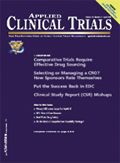Costs and Utility in Biomarker Use
Applied Clinical Trials
Considering the cost and value of biomarkers when deciding to use them in a clinical trial.
As the use of biomarkers in clinical trials increases, the decision to use a biomarker in a trial needs to be taken in consideration with the cost and value they bring. Patrice Hugo, PhD, VP Scientific Affairs, Global Central Lab, MDS Pharma Services, told attendees of the recent IIR Central Labs Partnering Conference that the first thing any sponsor should do is clearly define the intended use of the biomarker for its clinical trial.

Biomarkers for Clinical Trials
"It is so important that it must be the first thing in the RFP," Hugo told Applied Clinical Trials. And it is important to take the time to specify the requirement, he notes, because of the impacts to the information that biomarker use will bring in the clinical trial. To determine these critical and uncritical biomarkers at the outset of the trial is crucial to cost control and experimental drug design. For example, critical biomarkers would be used to determine exclusion/inclusion criteria, or used as a direct measure of drug efficacy being the primary surrogate endpoint. Said Hugo, "In this case, the relationship between the clinical outcome and the biomarker is not necessarily perfect, but is good enough to make a decision. For instance, CD4 count in HIV trials is a well-known surrogate endpoint." An uncritical biomarker, then, is one that is not used to make immediate decisions in the trials. For example, it would bring insight into the disease or the mechanism of the drug.
Role of the central lab
In addition, for the sponsor evaluating its cost/benefit to using a biomarker, the testing process is a factor. Hugo explained: "Several biomarkers are measured by using high throughput technology platforms testing several samples at once and/or using multiplex technologies where one sample is simultaneously tested for various markers at once." For those instances, he said, it makes sense to batch the samples and only perform testing when a high enough number of samples are available. Although, this reduces the cost, it is not always possible when the results are needed in a very short time frame after the patient visit.
Biomarker use has also changed the traditional role of a central lab. According to Hugo, central labs used to perform safety testing almost exclusively. "Typically, safety testing requires high sample handling and logistics, short-term availability of capacity, fast turn around time (i.e., usually less than 48 hours), large to very large volumes of samples, data comparability between laboratory sites, and adequate regulatory accreditations and approvals," explained Hugo.
With the advent of biomarker and esoteric testing in central labs, new requirements or constraints include technology transfer from sponsors, tailored designed assays, pushing technical specifications of commercially available kits, "fit-for-purpose validation," ad hoc proficiency testing, increased logistics around frozen management and batched sample testing, and customized analytical reports.
All food for thought for the sponsor partnering with a central lab in its biomarker forays.

Improving Relationships and Diversifying the Site Selection Process
April 17th 2025In this episode of the Applied Clinical Trials Podcast, Liz Beatty, co-founder and chief strategy officer, Inato, discusses a number of topics around site engagement including community-based sites, the role of technology in improving site/sponsor relationships, how increased operational costs are impacting the industry, and more.
Behind the Buzz: Why Clinical Research Leaders Flock to SCOPE Summit
February 7th 2025In this episode, we meet with Micah Lieberman, Executive Conference Director for SCOPE Summit (Summit for Clinical Ops Executives) at Cambridge Innovation Institute. We will dive deep into the critical role of collaboration within the clinical research ecosystem. How do we bring together diverse stakeholders—sponsors, CROs, clinical trial tech innovators, suppliers, patients, sites, advocacy organizations, investors, and non-profits—to share best practices in trial design, program planning, innovation, and clinical operations? We’ll explore why it’s vital for thought leaders to step beyond their own organizations and learn from others, exchanging ideas that drive advancements in clinical research. Additionally, we’ll discuss the pivotal role of scientific conferences like SCOPE Summit in fostering these essential connections and collaborations, helping shape the future of clinical trials. Join us as we uncover how collective wisdom and cross-industry partnerships are transforming the landscape of clinical research.